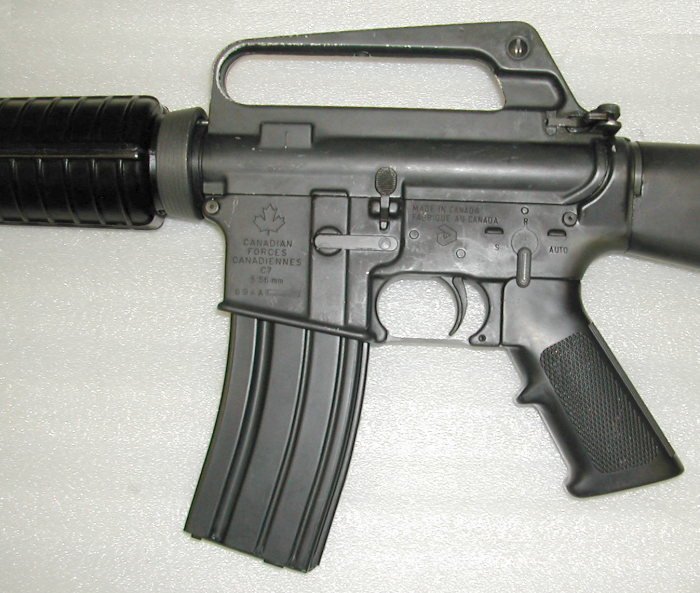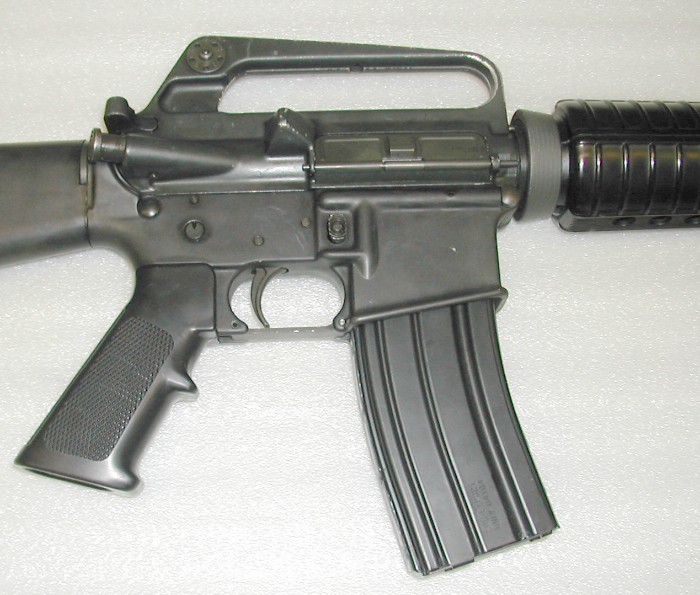

A pistol or submachinegun were the primary weapons carried by Canadian MPs in the field and by the late 1950s, World War 2 vintage Sten submachineguns were replaced by the Sterling SMG C1. The current submachinegun in Canadian service is the Heckler & Koch MP5 which is a limited issue primarily for Special Forces and Close Protection duties.
The current primary weapons for Canadian MPs are the Sig Sauer P225 and C7 series of rifles. Light and Medium Machineguns may be mounted on vehicles or at fixed positions covering checkpoints or roadblocks. Various models of 12 gauge shotguns and certain other special purpose weapons are also availible for issue.
The SMG C1 is a "Canadianised" version of the British Patchett Stirling SMG. It was manufactured by Canadian Arsenals Ltd at Long Branch, a suburb of Toronto Ontario. The standard magazine holds 30 rounds, and a 10 round magazine is provided for use by vehicle crews. The SMG is selective fire and has a 100 and 200 yard aperature rear sight. It had a folding stock and was fitted for the standard Canadian C1 rifle bayonet. The SMG C1 was very popular and remained in service until the mid 1980s, when it was withdrawn and placed in war reserve stock.



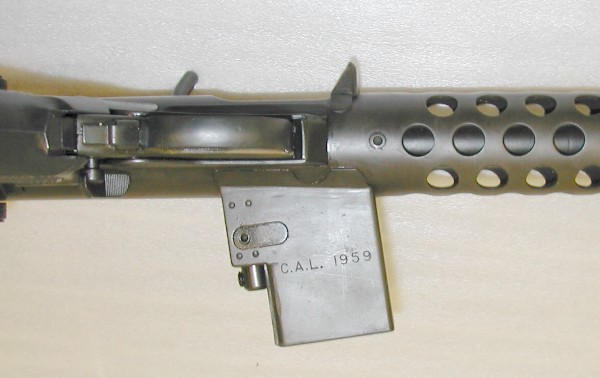


The Colt Cobra was an alloy frame 6 shot single or double action revolver in .38 Special.
The Cobra was the primary weapon carried by members of the Special Investigation Unit. As plainclothes investigators, members of the SIU required a pistol that was easy to conceal. The Colt Cobra is now obsolete.
Action: Double action revolver
Calibre: .38 Special
Barrel Length: 3 inches (76.2 mm)
Number of Shots: 6
In Service: C 1970 - late 1980s (?)

This pistol was the initial duty weapon for female Military Police from 1974 until it was replaced by the Browning Hi-Power.
This pistol is now obsolete.
Action: revolver
Calibre: .38 Special
Barrel Length: 3 inches (76.2 mm)
Number of Shots: 5
Quantity: 518 (1974)

The primary pistol in use by the Canadian Military Police was the 9 mm Browning Hi Power. Throughout it's service, these pistols have undergone a number of upgrades, but it has become apparent that it's useful service life is coming to an end. Vintage magazines are especially prone to failure and many have been replaced by modern magazines. The 9mm calibre in handguns is verging on obsolete for police and military use, 10mm or .40 calibre are becoming standard. The use of the Browning by Regular Military Police has been phased out, they have been replaced by the Sig Sauer P225. The Browning is still standard for the Reserves.
Action: Semi automatic
Calibre: 9mm (9 X 19mm NATO)
Overall Length: 200mm
Barrel Length: 118mm
Number of Shots:13
In Service: 1944 - present.

The German made Sig Sauer P225 was trialled in 1991 and adopted as the replacement for the Browning Hi-Power in that year. The P225 is similar to the Browning in size and handling characteristics, making transition training relatively simple.
Action: semi automatic
Calibre: 9mm (9 X 19mm NATO)
Overall Length: 180mm
Barrel Length: 98mm
Number of Shots: 8
In Service: 1991 - present
A centerpiece of the 1980s Small arms replacement Project was the adoption of the C9 light machinegun which was chosen as a replacement for the FNC2 automatic rifle. The C9 Light Machinegun is the Canadian designation for the Belgian 5.56mm Fabrique Nationale (FN) Minimi Squad Automatic Weapon. The C9 is an air cooled, gas operated, belt or magazine fed, automatic weapon weighing approximately 7 kg. The barrel is quick-detachable, and has a carrying handle attached to it. The C9 uses disintegrating link belts, or a C7 rifle magazine. A 200 round belt is carried in a plastic box clipped beneath the receiver. A folding bipod is mounted under the gas chamber, and the gun may also be mounted on a tripod or vehicle.
There are 3 versions of the C9:
1. C9 with tubular buttstock and open sights;
2. C9A1 with a Elcan C79 optical sight mounted on a Picatinny rail on the feed cover
3. C9A2. The C9A2 is a mid life upgrade with the Elcan C79A1 optical sight, a collapsible buttstock, shorter barrel, green furniture and a laser aiming module.
In it's role as a Squad or Section Automatic the C9 was a fine weapon, superior to the magazine fed FNC2. It is light, accurate and capable of maintaining a high volume of fire. A major drawback however is it's light calibre. 5.56mm is not capable of pentrating even light barriers at medium ranges.

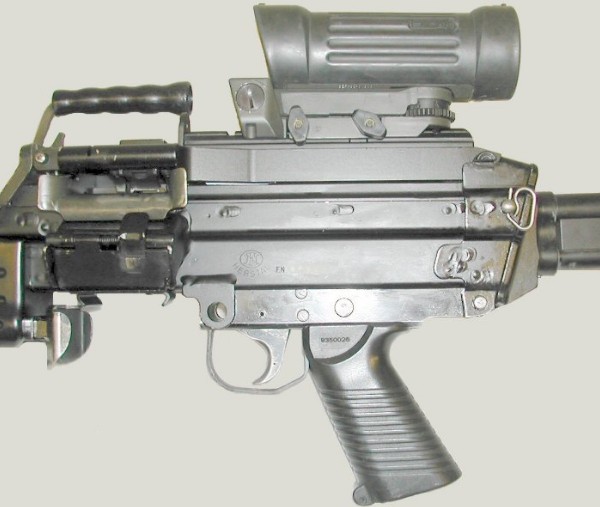
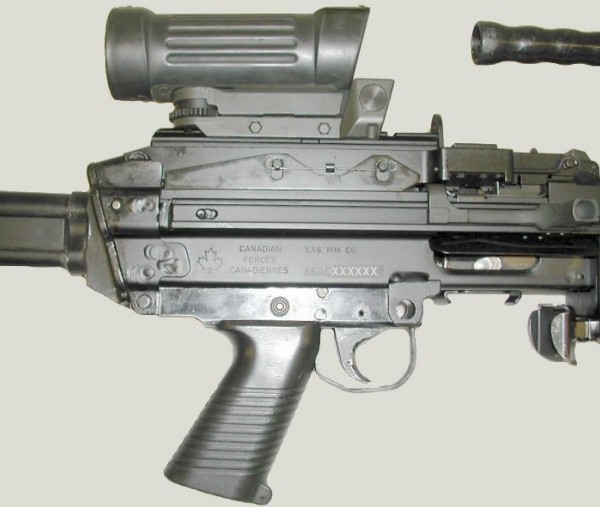

The 5.56mm (.223 calibre) C7 rifle was adopted by Canada in the mid 1980s as part of the Small Arms Replacement Project (SARP). The C7 was initially regarded by many Canadian soldiers (who were used to the heavier FNC1A1) as a "Mickey Mouse" rifle, due to it's light weight and plastic furniture. This attitude changed once the C7's reliability and accuracy were demonstrated.
The C7 series of rifles are made in Canada by Diemaco (now called Colt Canada)
The C7 was a close copy of the American M16A2, with a few differences. Canadian made rifles had 3 lengths of butt; the front and rear sights were different and of better quality; and the rifle was capable of both semi and full automatic fire, whereas the M16A2 was capable of semi automatic or 3 round bursts. The Canadian made barrel was similar to the American, but was
hammer forged.
Originally, the C7 was issued with 30 round plastic magazines, these were prone to damage and by the early 1990s were being replaced by standard American metal magazines. The C7 bayonet was Canadian made by the Nella cutlery company and was similar to the American M7 bayonet. C7 bayonets are currently being replaced by the Eickhorn C-2000 bayonet.

